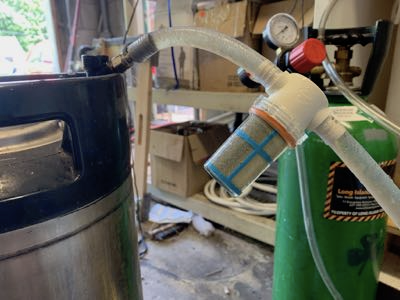I plan on dry hopping my IPAs in my new 7-Gallon SSB Unitank and will likely use somewhere in the range of 3-6 oz of pellet hops per charge, possibly multiple charges with a dump in between. I have had and most certainly do not enjoy clogged poppets on my kegs due to stray hop particles and am wondering what folks are doing to keep these particles out of the keg during closed transfer.
Quick history – I used to ferment in carboys and used a siphon to rack to the keg. A piece of paint strainer bag was usually tied to the end of the racking cane to prevent hop particles from entering the line but apparently this did not always work hence the clogged poppets.
I’ve also viewed several posts from this and other forums on this subject and have seen many different solutions but could not readily see which solutions were the most effective, or what possible pitfalls there may have been along the way.
Things I have considered: in-line strainer (What kind? Will it clog?); hops in a strainer tube (400-ish micron mesh?) or a strainer bag with marbles dropped into the conical (how could I do this w/o introducing O2?); crashing for several days before transfer (seems simple but is it effective?); strainer bag on the end of my racking arm (just thought of that one – weird, no?)
Haven’t tried any of this yet as I’m still putting the finishing touches on the new brewery, but I also do not want to go through any unnecessary steps or see any spectacular failures and would like to tap into your experiences on this subject. Ideas?
Quick history – I used to ferment in carboys and used a siphon to rack to the keg. A piece of paint strainer bag was usually tied to the end of the racking cane to prevent hop particles from entering the line but apparently this did not always work hence the clogged poppets.
I’ve also viewed several posts from this and other forums on this subject and have seen many different solutions but could not readily see which solutions were the most effective, or what possible pitfalls there may have been along the way.
Things I have considered: in-line strainer (What kind? Will it clog?); hops in a strainer tube (400-ish micron mesh?) or a strainer bag with marbles dropped into the conical (how could I do this w/o introducing O2?); crashing for several days before transfer (seems simple but is it effective?); strainer bag on the end of my racking arm (just thought of that one – weird, no?)
Haven’t tried any of this yet as I’m still putting the finishing touches on the new brewery, but I also do not want to go through any unnecessary steps or see any spectacular failures and would like to tap into your experiences on this subject. Ideas?



